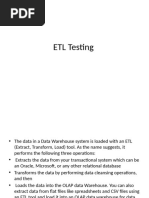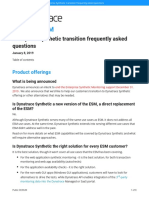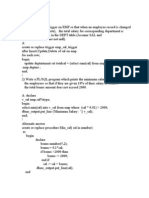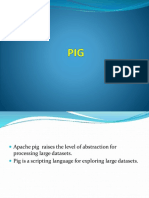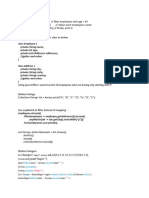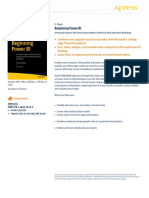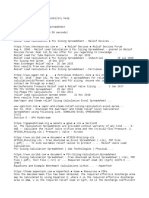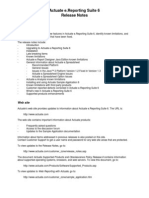0 ratings0% found this document useful (0 votes)
331 viewsCheat Sheet: The Pandas Dataframe Object: Column Index (DF - Columns)
This document provides a cheat sheet on loading, manipulating, and saving Pandas DataFrame objects. It describes how to load DataFrames from Excel files, SQL databases, Python dictionaries, and random NumPy arrays. It also explains how to get data into a DataFrame from Series, and how to save DataFrames to CSV and Excel files. Series objects contain ordered, one-dimensional data while DataFrames are two-dimensional tables containing Series in each column.
Uploaded by
Nirmala ShindeCopyright
© © All Rights Reserved
Available Formats
Download as PDF, TXT or read online on Scribd
0 ratings0% found this document useful (0 votes)
331 viewsCheat Sheet: The Pandas Dataframe Object: Column Index (DF - Columns)
This document provides a cheat sheet on loading, manipulating, and saving Pandas DataFrame objects. It describes how to load DataFrames from Excel files, SQL databases, Python dictionaries, and random NumPy arrays. It also explains how to get data into a DataFrame from Series, and how to save DataFrames to CSV and Excel files. Series objects contain ordered, one-dimensional data while DataFrames are two-dimensional tables containing Series in each column.
Uploaded by
Nirmala ShindeCopyright
© © All Rights Reserved
Available Formats
Download as PDF, TXT or read online on Scribd
You are on page 1/ 6
Cheat Sheet: The Pandas DataFrame Object
Load a DataFrame from a Microsoft Excel file
Preliminaries # put each Excel workbook in a dictionary
workbook = pd.ExcelFile('file.xls')
d = {}
Start by importing these Python modules for name in workbook.sheet_names:
import numpy as np # required df = workbook.parse(name)
import pandas as pd # required d[name] = df
from pandas import DataFrame, Series # useful
Load a DataFrame from a MySQL database
import MySQLdb as db
import pandas.io.sql as ps
The conceptual model cx = db.connect('localhost', 'username',
'password', 'database')
df = ps.frame_query('SELECT * FROM data', cx)
Series object: an ordered, one-‐dimensional
array of data with an index. All the data in Get a DataFrame from a Python dictionary
a Series is of the same data type. Series # default – assume your data in columns
arithmetic is vectorised after first aligning df = DataFrame({
the Series index for each of the operands. 'col0' : [1.0, 2.0, 3.0, 4.0],
s1 = Series(range(0,4)) # -‐-‐> 0, 1, 2, 3 'col1' : [100, 200, 300, 400]
s2 = Series(range(1,5)) # -‐-‐> 1, 2, 3, 4 })
s3 = s1 + s2 # -‐-‐> 1, 3, 5, 7
s4 = Series(['a','b'])*3 # -‐-‐> 'aaa', 'bbb' # use helper method for data in rows
df = DataFrame.from_dict({ # data by row
DataFrame object: a two-‐dimensional table of 'row0' : {'col0':0, 'col1':'A'},
data with column and row indexes. The columns 'row1' : {'col0':1, 'col1':'B'}
are made up of pandas Series objects. }, orient='index')
df = DataFrame.from_dict({ # data by row
Column index (df.columns) 'row0' : [1, 1+1j, 'A'],
'row1' : [2, 2+2j, 'B']
}, orient='index')
Series of data
Series of data
Series of data
Series of data
Series of data
Series of data
Series of data
(df.index)
Row
index
Create play data (useful for testing)
# created from a 2D numpy array (of randoms)
df = DataFrame(np.random.randn(26,5),
columns=['col'+str(i) for i in range(5)],
index=list("ABCDEFGHIJKLMNOPQRSTUVWXYZ"))
df['cat'] = list('aaaabbbccddef' * 2)
Get your data into a DataFrame Saving a DataFrame
Data in Series then combine into a DataFrame Writing DataFrames to CSV
# Exmaple 1 ... df.to_csv('filename.csv', encoding='utf-‐8')
s1 = Series(range(6))
s2 = s1 * s1 Writing DataFrames to Excel
s2.index = s2.index + 2 # misaligned indexes from pandas import ExcelWriter
df = pd.concat([s1, s2], axis=1) writer = ExcelWriter('filename.xlsx')
df1.to_excel(writer,'Sheet1')
# Exmaple 2 ... df2.to_excel(writer,'Sheet2')
s3 = Series({'Tom':1, 'Dick':4, 'Harry':9}) writer.save()
s4 = Series({'Tom':3, 'Dick':2, 'Mary':11})
df = pd.concat({'A': s3, 'B': s4 }, axis=1) Writing DataFrames to MySQL
Note: 1st method has in integer column labels import MySQLdb as db
Note: 2nd method does not guarantee col order cx = db.connect('localhost', 'username',
Note: index alignment on DataFrame creation 'password', 'database')
df.to_sql(name='tablename', con=cx,
Load a DataFrame from a CSV file flavour='mysql', if_exists='replace')
df = pd.read_csv('file.csv') Note: if_exists – 'fail', 'replace', 'append'
Version 16 August 2014 -‐ [Draft] 1
Working with row and column indexes Working with columns of data (axis=1)
DataFrames have two Indexes A DataFrame column is a pandas Series object
Typically, the column index is a list of
strings (observed variable names) or (less Selecting columns
commonly) integers. The row index might be s = df['colName'] # select column by name
• Integers -‐ for case or row numbers (default df = df[['a','b']] # select 2 or more cols
is numbered from 0 to length-‐1) df = df[['c','a','b']]# change column order
• Strings – for case names s = df[df.columns[0]] # select column by num
• DatetimeIndex or PeriodIndex – for time
series data (more on these indexes below) Selecting columns with Python attributes
s = df.a # same as s = df['a']
Get column index and labels df.existing_col = df.a / df.b
idx = df.columns # get col index # cannot create new columns by attribute ...
label = df.column[0] # 1st col label df['new_col'] = df.a / df.b
lst = df.columns.tolist() # get as a list Trap: column names must be valid identifiers.
Change column labels Adding new columns to a DataFrame
df.rename(columns={'old':'new'},inplace=True) df['new_col'] = range(len(df))
df = df.rename(columns = {'a':'a1','b':'b2'}) df['new_col'] = np.repeat(np.nan, len(df))
df['random'] = np.random.rand(len(df))
Get the row index and labels df['index_as_col'] = df.index
idx = df.index # get row index df1[['b','c']] = df2[['e','f']] # multi add
st
label = df.index[0] # 1 row label df3 = df1.append(other=df2) # multi add
lst = df.index.tolist() # get as a list
Swap column contents
Change the (row) index df[['B', 'A']] = df[['A', 'B']]
df.index = idx # new ad hoc index
df.index = range(len(df)) # set with list Dropping columns (by label)
df = df.reset_index() # replace old with new df = df.drop('col1', axis=1)
# note: old index stored as a col in df df.drop('col1', axis=1, inplace=True)
df = df.reindex(index=range(len(df))) df = df.drop(['col1','col2'], axis=1) # multi
df = df.set_index(keys=['col1','col2','etc']) s = df.pop('col') # get col; drop from frame
df.rename(index={'old':'new'}, inplace=True) del df['col'] # even classic python works
Get the integer position of a row index label Selecting columns with .loc, .iloc and .ix
i = df.index.get_loc('label') # also columns df = df.loc[:, 'col1':'col2'] #inclusive "to"
df = df.iloc[:, 0:2] #exclusive "to"
Sort DataFrame by its row or column index A slice of columns can be selected by label
df.sort_index(inplace=True) # sort by rows (using df.loc[rows, cols]); by integer
df = df.sort_index(axis=1) # sort by cols position (using df.iloc[rows, cols]); or a
hybrid of the two (using df.ix[rows, cols])
Test if the index values are unique/monotonic Note: the row slice object : copies all rows
if df.index.is_unique: pass # do something Note: For .loc, the indexes can be:
if df.columns.is_unique: pass # do something • A single label (eg. 'A')
if df.index.is_monotonic: pass # do something • A list/array of labels (eg. ['A', 'B'])
if df. columns.is_monotonic: pass # something • A slice object of labels (eg. 'A':'C')
For a monotonic index, each element is • A Boolean array
greater than or equal to the previous element Note: For .iloc, the indexes can be
• A single integer (eg. 27)
Drop duplicates in the row index • A list/array of integers (eg. [1, 2, 6])
df['index'] = df.index # 1 create new col • A slice object with integers (eg. 1:9)
df = df.drop_duplicates(cols='index',
take_last=True) # 2 use new col Vectorised arithmetic on columns
del df['index'] # 3 del the col df['proportion'] = df['count'] / df['total']
df.sort_index(inplace=True)# 4 tidy up df['percent'] = df['proportion'] * 100.0
Test if two DataFrames/Series have same index Apply numpy mathematical functions to columns
len(a) == len(b) and all(a.index == b.index) df['log_data'] = np.log(df['col1'])
df['rounded'] = np.round(df['col2'], 2)
Version 16 August 2014 -‐ [Draft] 2
Columns value set based on criteria
# Option 1: using a mask Working with rows (axis=0)
df['new'] = 0
df[df['c'] > 0]['new'] = df['c']
# Option 2: using the where statement Adding rows
df['new'] = df['c'].where(df['c']>0, other=0) df = original_df.append(more_rows_in_df)
Note: Multiple conditions can be combined Hint: convert to a DataFrame and then append.
using & and | with conditions in parentheses. Both DataFrames should have same col labels.
Note: where other can be a Series or a scalar
Note: ~ the boolean not operator for pandas Dropping rows (by name)
df = df.drop('row_label')
Iterating over the Dataframe cols df = df.drop(['row1','row2']) # multi-‐row
for (column, series) in df.iteritems():
# do something ... Boolean row selection by values in a column
Where column is the label and series is a df = df[df['col2'] >= 0.0]
pandas Series that contains the column data. df = df[(df['col3']>=1.0) | (df['col1']<0.0)]
df = df[df['col'].isin([1,2,5,7,11])]
Common column-‐wide methods/attributes df = df[~df['col'].isin([1,2,5,7,11])] # not
value = df['col1'].dtype # type of data df = df[df['col'].str.contains('hello')]
value = df['col1'].size # col dimensions Trap: bitwise "or" and "and" co-‐opted to be
value = df['col1'].count() # non-‐NA count Boolean operators on a Series of Boolean -‐-‐>
value = df['col1'].sum() also note parentheses around comparisons.
value = df['col1'].prod()
value = df['col1'].min() Select a slice of rows by integer position
value = df['col1'].max() [inclusive-‐from : exclusive-‐to]
value = df['col1'].mean() [inclusive-‐from : exclusive-‐to : step]
value = df['col1'].median() default start is 0; default end is len(df)
value = df['col1'].cov(df['col2'])
df = df[:] # copy DataFrame
s = df['col1'].describe()
df = df[0:2] # rows 0 and 1
s = df['col1'].value_counts()
df = df[-‐1:] # the last row
df = df[2:3] # row 2 (the third row)
Find index for min/max values in column df = df[:-‐1] # all but the last row
value = df['col1'].idxmin() # returns label nd
df = df[::2] # every 2 row (0 2 ..)
value = df['col1'].idxmax() # returns label Trap: a single integer without a colon is a
column index for numbered columns.
Common column element-‐wise methods
s = df['col'].to_datetime() Select a slice of rows by label/index
s = df['col1'].isnull() [inclusive-‐from : inclusive–to [ : step]]
s = df['col1'].notnull() # not isnull() df = df['a':'c'] # rows 'a' through 'c'
s = df['col1'].astype('float') # type convert Trap: doesn't work on integer labelled rows
s = df['col1'].round(decimals=0)
s = df['col1'].diff(periods=1) Append a row of column totals to a DataFrame
s = df['col1'].shift(periods=1)
# Option 1: using a dictionary comprehension
s = df['col1'].fillna(0) # replace NaN with 0
sums = {col: df[col].sum() for col in df}
s = df['col1']. pct_change(periods=4)
sums_df = DataFrame(sums, index=['Total'])
s = df['c'].rolling_min(periods=4, window=4)
df = df.append(sums_df)
s = df['c'].rolling_max(periods=4, window=4)
# Option 2: All done with pandas
s = df['c'].rolling_sum(periods=4, window=4)
df = df.append(DataFrame(df.sum(),
columns=['Total']).T) # .T is transpose
Append a column of row totals to a DataFrame
df['Total'] = df.sum(axis=1) Iterating over DataFrame rows
Note: can do row means, mins, maxs, etc. in a for (index, row) in df.iterrows():
similar manner.
Trap: row data type may be coerced.
Group by a column
Sorting DataFrame rows by column values
s = df.groupby('cat')['col1'].sum()
df = df.sort(df.columns[0], ascending=False)
dfg = df.groupby('cat').sum()
df.sort(['col1', 'col2'], inplace=True)
Group by a row index (non-‐hierarchical index)
Remember!
df = df.set_index(keys='cat')
w = df['label'] # a selected column
s = df.groupby(level=0)['col1'].sum()
x = df[['L1', 'L2']] # selected columns
dfg = df.groupby(level=0).sum()
y = df['label':'label'] # selected rows
z = df[i:j] # where i & j are ints, à rows
Version 16 August 2014 -‐ [Draft] 3
Working with cells Joining/Combining DataFrames
Selecting a cell by row and column labels Three ways to join two DataFrames:
value = df.at['row', 'col'] • merge (a database/SQL-‐like join operation)
value = df.loc['row', 'col'] • concat (stack side by side or stack one on
value = df['col']['row'] # tricky top of the other)
Note: .at[] fastest label based scalar lookup • combine_first (splice the two togther,
choosing values from one over the other)
Setting a cell by row and column labels
df.at['row, 'col'] = value Merge on indexes
df.loc['row, 'col'] = value df_new = pd.merge(left=df1, right=df2,
df['col']['row'] = value # tricky how='outer', left_index=True,
right_index=True)
Selecting and slicing on labels How: 'left', 'right', 'outer', 'inner'
df = df.loc['row1':'row3', 'col1':'col3'] How: outer=union/all; inner=intersection
Note: the "to" on this slice is inclusive.
Merge on columns
Setting a cross-‐section by labels df_new = pd.merge(left=df1, right=df2,
df.loc['A':'C', 'col1':'col3'] = np.nan how='left', left_on='col1', right_on='col2')
df.loc[1:2, 'col1':'col2'] = np.zeros((2,2)) Trap: When joining on columns, the indexes on
df.loc[1:2, 'A':'C'] = other.loc[1:2,'A':'C'] the passed DataFrames are ignored.
Remember: inclusive from:to in the slice Trap: many-‐to-‐many merges on a column can
result in an explosion of associated data.
Selecting a cell by integer position
Join on indexes (another way of merging)
value = df.iat[9, 3] # [row, col]
value = df.iloc[0, 0] # [row, col] df_new = df1.join(other=df2, on='col1',
value = df.iloc[len(df)-‐1, len(df.columns)-‐1] how='outer')
df_new = df1.join(other=df2, on=['a', 'b'],
Selecting a range of cells by int position how='outer')
df = df.iloc[2:4, 2:4]# a subset of the df Note: DataFrame.join() joins on indexes by
df = df.iloc[:5, :5] # top left corner default. DataFrame.merge() joins on common
s = df.iloc[5, :] # returns row as Series columns by default.
df = df.iloc[5:6, :] # returns row as a row
Simple concatenation is often the best
Note: exclusive "to" – same as list slicing.
df=pd.concat([df1,df2],axis=0) # top/bottom
Setting cell by integer position df = df1.append([df2, df3]) # top/bottom
df=pd.concat([df1,df2],axis=1) # left/right
df.iloc[0, 0] = value # [row, col]
df.iat[7, 8] = value Trap: can end up with duplicate rows or cols
Note: concat has an ignore_index parameter
Setting cell range by integer position
Combine_first
df.iloc[0:3, 0:5] = value
df = df1.combine_first(other=df2)
df.iloc[1:3, 1:4] = np.ones((2,3))
df = reduce(lambda x, y: x.combine_first(y),
Remember: exclusive from:to in the slice [df1, df2, df3, df4, df5])
Uses the non-‐null values from df1. The index
Operate on the whole DataFrame
of the combined DataFrame will be the union
# replace np.nan with 0 of the indexes from df1 and df2.
df.fillna(0, inplace=True)
# replace white space with np.nan
df = df.replace(r'\s+', np.nan, regex=True)
Working with the whole DataFrame
Views and copies
From the manual: The rules about when a view
on the data is returned are dependent on
Peek at the DataFrame
NumPy. Whenever an array of labels or a
boolean vector are involved in the indexing summary_df = df.describe()
operation, the result will be a copy. A head_df = df.head(); tail_df = df.tail()
single label/scalar indexing & slicing, e.g. top_left_corner_df = df.iloc[:5, :5]
df.ix[3:6] or df.ix[:, 'A'], returns a view.
Other useful
df = df.T # transpose rows and columns
df2 = df.copy() # copy a DataFrame
Version 16 August 2014 -‐ [Draft] 4
Error handling with dates
Working with dates, times and their indexes # first example returns string not Timestamp
s = pd.to_datetime('2014-‐02-‐30')
# second example returns NaT (not a time)
Dates and time – points and spans n = pd.to_datetime('2014-‐02-‐30', coerce=True)
With its focus on time-‐series data, pandas # NaT is like NaN ... tests True for isnull()
provides a suite of tools for managing dates b = pd.isnull(n) # -‐-‐> True
and time: either as a point in time (a
Timestamp) or as a span of time (a Period). Creating date/period indexes from scratch
timestamp = pd.Timestamp('2013-‐01-‐01') dt_idx = pd.DatetimeIndex(pd.date_range(
period = pd.Period('2013-‐01-‐01', freq='M') start='1/1/2011', periods=12, freq='M'))
p_idx = pd.period_range('1960-‐01-‐01',
Dates and time – stamps and spans as indexes '2010-‐12-‐31', freq='M')
An index of Timestamps is a DatetimeIndex;
and an index of Periods is a PeriodIndex. Row selection with a time-‐series index
These can be constructed as follows: # play data ... start with play data above
date_strs = ('2013-‐10-‐01', '2013-‐11-‐01', idx = pd.period_range('2013-‐01',
'2013-‐12-‐01', '2014-‐01-‐01') periods=len(df), freq='M')
tstamp = pd.to_datetime(pd.Series(date_strs)) df.index = idx
dt_idx = pd.DatetimeIndex(tstamp, freq='MS')
prd_idx = pd.PeriodIndex(tstamp, freq='M') february_selector = (df.index.month == 2)
spi = Series([1,2,3,4], index=prd_idx) february_data = df[february_selector]
sdi = Series([1,2,3,4], index=dt_idx)
# Also: index changed through its attribute q1_data = df[(df.index.month >= 1) &
spi.index = dt_idx # change to time stamps (df.index.month <= 3)] # note: & not "and"
spi.index = range(len(spi)) # to integers
mayornov_data = df[(df.index.month == 5) |
From DatetimeIndex and PeriodIndex and back (df.index.month == 11)] # note: | not "or"
spi = sdi.to_period(freq='M')# to PeriodIndex
sdi = spi.to_timestamp() # to DatetimeIndex annual_tot = df.groupby(df.index.year).sum()
Note: from period to timestamp defaults to Also: year, month, day [of month], hour,
the point in time at the start of the period. minute, second, dayofweek [Mon=0 .. Sun=6],
weekofmonth, weekofyear [numbered from 1],
Frequency constants (not a complete list) week starts on Monday], dayofyear [from 1], …
Name Description Note: this method works with both Series and
DataFrame objects.
U Microsecond
L Millisecond
The tail of a time-‐series DataFrame
S Second
df = df.last("5M") # the last five months
T Minute
H Hour
D Calendar day
B Business day
Working with strings
W-‐{MON, TUE, …} Week ending on …
MS Calendar start of month
M Calendar end of month Working with strings
QS-‐{JAN, FEB, …} Quarter start with year # assume that df['col'] is series of strings
starting (QS – December) s = df['col'].str.lower()
Q-‐{JAN, FEB, …} Quarter end with year s = df['col'].str.upper()
ending (Q – December) s = df['col'].str.len()
AS-‐{JAN, FEB, …} Year start (AS -‐ December) df['col'] += 'suffix' # add text to each row
A-‐{JAN, FEB, …} Year end (A -‐ December) df['col'] *= 2 # repeat text
s = df['col1'] + df['col2'] # concatenate
More examples on working with dates/times Most python string functions are replicated
d = pd.to_datetime(['04-‐01-‐2012'], in the pandas DataFrame and Series objects.
dayfirst=True) # Australian date format
t = pd.to_datetime(['2013-‐04-‐01 15:14:13.1']) Regular expressions
DatetimeIndex can be converted to an array of s = df['col'].str.contains('regex')
Python native datetime.datetime objects using s = df['col'].str.startswith('regex')
the to_pydatetime() method. s = df['col'].str.endswith('regex')
s = df['col'].str.replace('old', 'new')
Note: pandas has many more regex methods
Version 16 August 2014 -‐ [Draft] 5
Categorical into DataFrame
Working with missing and non-‐finite data You can put a column of encoded Categorical
data in the DataFrame, but in the process the
factor information will be lost; so you will
Working with missing data need to hold this factor information outside
Pandas uses the not-‐a-‐number construct of the DataFrame.
(np.nan and float('nan')) to indicate missing factor = pd.Categorical.from_array(df['cat'])
data. The Python None can arise in data as df['labels'] = factor.labels # integers only
well. It is also treated as missing data; as df['cat2'] = factor # converts back to string
is the pandas not-‐a-‐time (pd.NaT) construct.
Missing data in a Series
s = pd.Series([8,None,float('nan'),np.nan]) Basic Statistics
# -‐-‐> [8, NaN, NaN, NaN]
s.isnull() # -‐-‐> [False, True, True, True]
s.notnull()# -‐-‐> [True, False, False, False] Summary statistics
s = df['col1'].describe()
Missing data in a DataFrame df1 = df.describe()
df = df.dropna() # drop all rows with a NaN
df = df.dropna(axis=1) # as above for cols Value counts
df=df.dropna(how='all') # only if all in row s = df['col1'].value_counts()
df=df.dropna(thresh=2) # at least 2 NaN in r
# only drop row if NaN in a specified 'col' Cross-‐tabulation (frequency count)
df = df.dropna(df['col'].notnull())
ct = pd.crosstab(index=df['a'], cols=df['b'])
Non-‐finite numbers
Quantiles and ranking
With floating point numbers, pandas provides
for positive and negative infinity. q = df.quantile(q=[0.05,0.25,0.5,0.75,0.95])
r = df.rank()
s = Series([float('inf'), float('-‐inf'),
np.inf, -‐np.inf]) # inf, -‐inf, inf, -‐inf
Histogram binning
Pandas treats integer comparisons with plus
or minus infinity as expected. count, bins = np.histogram(df['col1'])
count, bins = np.histogram(df['col'], bins=5)
Testing for finite numbers count, bins = np.histogram(df['col1'],
(using the data from the previous example) bins=[-‐3,-‐2,-‐1,0,1,2,3,4])
np.isfinite(s) # False, False, False, False
Correlation and covariance
df_cm = df.corr()
df_cv = df.cov()
Working with Categorical Data
Regression
import statsmodels.formula.api as sm
Categorical data result = sm.ols(formula="col1 ~ col2 + col3",
The pandas Series has an R factors-‐like data data=df).fit()
type for encoding categorical data into print (result.params)
integers. print (result.summary())
c = pd.Categorical.from_array(list)
c.levels # -‐-‐> the coding frame Smoothing example using rolling_apply
c.labels # -‐-‐> the encoded integer array k3x5 = np.array([1,2,3,3,3,2,1]) / 15.0
c.describe # -‐-‐> the values and levels s = pd.rolling_apply(df['col1'], window=7,
func=lambda x: (x * k3x5).sum(),
Indexing categorical data min_periods=7, center=True)
The categorical data can be indexed in a
manner conceptually similar to that for
Series.iloc[] above:
listy = ['a', 'b', 'a', 'b', 'b', 'c']
c = pd.Categorical.from_array(listy)
c.levels # -‐-‐> ['a', 'b', 'c']
c.labels # -‐-‐> [0, 1, 0, 1, 1, 2]
x = c[1] # -‐-‐> 'b'
x = c[[0,1]] # -‐-‐> ['a', 'b']
x = c[0:2] # -‐-‐> ['a', 'b']
Version 16 August 2014 -‐ [Draft] 6
You might also like
- Visit Our Infosys Interview Preparation DashboardNo ratings yetVisit Our Infosys Interview Preparation Dashboard7 pages
- Object Oriented Programming Methodology (CS and IT)No ratings yetObject Oriented Programming Methodology (CS and IT)2 pages
- DB Campus Drive Preparation Materials Geeks4GeeksNo ratings yetDB Campus Drive Preparation Materials Geeks4Geeks14 pages
- Crunchy Postgresql High-Availability Suite Keeps Critical Applications RunningNo ratings yetCrunchy Postgresql High-Availability Suite Keeps Critical Applications Running2 pages
- Jpa (Java Persistence Api) Cheat Sheet: Transaction Management With EntitymanagerNo ratings yetJpa (Java Persistence Api) Cheat Sheet: Transaction Management With Entitymanager8 pages
- Laravel Interview Questions With AnswersNo ratings yetLaravel Interview Questions With Answers4 pages
- Talend Tutorial5 Filtering Data Using The TMap ComponentNo ratings yetTalend Tutorial5 Filtering Data Using The TMap Component2 pages
- Enterprise Synthetic Transition Frequently Asked Questions-V44-20190108 - 1720No ratings yetEnterprise Synthetic Transition Frequently Asked Questions-V44-20190108 - 17208 pages
- Structured, Flexible Guided: For Tech Professionals To Accelerate Their CareerNo ratings yetStructured, Flexible Guided: For Tech Professionals To Accelerate Their Career16 pages
- Content-Management With Apache Jack RabbitNo ratings yetContent-Management With Apache Jack Rabbit22 pages
- Binary Tree - Interview Questions and Practice ProblemsNo ratings yetBinary Tree - Interview Questions and Practice Problems9 pages
- Java Programming Cheat Sheet For Beginners - EdurekaNo ratings yetJava Programming Cheat Sheet For Beginners - Edureka8 pages
- Data Structure Calicut University 2nd SemNo ratings yetData Structure Calicut University 2nd Sem20 pages
- Exception? A Catch Block That Catches The Exception of Type System - Exception. You Can Also Omit The100% (1)Exception? A Catch Block That Catches The Exception of Type System - Exception. You Can Also Omit The6 pages
- Name: Wable Snehal Mahesh Subject:-Scala & Spark Div: - Mba Ii Roll No: - 57 Guidence Name: - Prof. Archana Suryawanshi - KadamNo ratings yetName: Wable Snehal Mahesh Subject:-Scala & Spark Div: - Mba Ii Roll No: - 57 Guidence Name: - Prof. Archana Suryawanshi - Kadam11 pages
- Java Interview Questions For 2 Years ExperiencedNo ratings yetJava Interview Questions For 2 Years Experienced8 pages
- The Datadog Handbook: A Guide to Monitoring, Metrics, and TracingFrom EverandThe Datadog Handbook: A Guide to Monitoring, Metrics, and TracingNo ratings yet
- Value Added Services For Tender ServicesNo ratings yetValue Added Services For Tender Services2 pages
- Beginning Power BI: A Practical Guide To Self-Service Data Analytics With Excel 2016 and Power BI DesktopNo ratings yetBeginning Power BI: A Practical Guide To Self-Service Data Analytics With Excel 2016 and Power BI Desktop1 page
- Aditya Ashok Desai: Computer Science and EngineeringNo ratings yetAditya Ashok Desai: Computer Science and Engineering1 page
- LSMW Long Text Load by Direct Input MethodNo ratings yetLSMW Long Text Load by Direct Input Method21 pages
- Project of It On Punjab Group of Colleges: Submitted ToNo ratings yetProject of It On Punjab Group of Colleges: Submitted To59 pages
- How To Remove First Last X Characters or Certain Position Characters From Text in ExcelNo ratings yetHow To Remove First Last X Characters or Certain Position Characters From Text in Excel27 pages
- Complete Answer Guide for Shelly Cashman Series Microsoft Office 365 and Publisher 2016 Comprehensive Loose leaf Version 1st Edition Starks Solutions Manual100% (6)Complete Answer Guide for Shelly Cashman Series Microsoft Office 365 and Publisher 2016 Comprehensive Loose leaf Version 1st Edition Starks Solutions Manual32 pages
- Contractors' Essential Guide For GRAPHISOFT ARCHICAD 2016 PDFNo ratings yetContractors' Essential Guide For GRAPHISOFT ARCHICAD 2016 PDF80 pages
- Sending Data From Arduino To Excel and Plotting ItNo ratings yetSending Data From Arduino To Excel and Plotting It12 pages
- Object Oriented Programming Methodology (CS and IT)Object Oriented Programming Methodology (CS and IT)
- Crunchy Postgresql High-Availability Suite Keeps Critical Applications RunningCrunchy Postgresql High-Availability Suite Keeps Critical Applications Running
- Jpa (Java Persistence Api) Cheat Sheet: Transaction Management With EntitymanagerJpa (Java Persistence Api) Cheat Sheet: Transaction Management With Entitymanager
- Talend Tutorial5 Filtering Data Using The TMap ComponentTalend Tutorial5 Filtering Data Using The TMap Component
- Enterprise Synthetic Transition Frequently Asked Questions-V44-20190108 - 1720Enterprise Synthetic Transition Frequently Asked Questions-V44-20190108 - 1720
- Structured, Flexible Guided: For Tech Professionals To Accelerate Their CareerStructured, Flexible Guided: For Tech Professionals To Accelerate Their Career
- Binary Tree - Interview Questions and Practice ProblemsBinary Tree - Interview Questions and Practice Problems
- Java Programming Cheat Sheet For Beginners - EdurekaJava Programming Cheat Sheet For Beginners - Edureka
- Exception? A Catch Block That Catches The Exception of Type System - Exception. You Can Also Omit TheException? A Catch Block That Catches The Exception of Type System - Exception. You Can Also Omit The
- Name: Wable Snehal Mahesh Subject:-Scala & Spark Div: - Mba Ii Roll No: - 57 Guidence Name: - Prof. Archana Suryawanshi - KadamName: Wable Snehal Mahesh Subject:-Scala & Spark Div: - Mba Ii Roll No: - 57 Guidence Name: - Prof. Archana Suryawanshi - Kadam
- The Datadog Handbook: A Guide to Monitoring, Metrics, and TracingFrom EverandThe Datadog Handbook: A Guide to Monitoring, Metrics, and Tracing
- Beginning Power BI: A Practical Guide To Self-Service Data Analytics With Excel 2016 and Power BI DesktopBeginning Power BI: A Practical Guide To Self-Service Data Analytics With Excel 2016 and Power BI Desktop
- Aditya Ashok Desai: Computer Science and EngineeringAditya Ashok Desai: Computer Science and Engineering
- Project of It On Punjab Group of Colleges: Submitted ToProject of It On Punjab Group of Colleges: Submitted To
- How To Remove First Last X Characters or Certain Position Characters From Text in ExcelHow To Remove First Last X Characters or Certain Position Characters From Text in Excel
- Complete Answer Guide for Shelly Cashman Series Microsoft Office 365 and Publisher 2016 Comprehensive Loose leaf Version 1st Edition Starks Solutions ManualComplete Answer Guide for Shelly Cashman Series Microsoft Office 365 and Publisher 2016 Comprehensive Loose leaf Version 1st Edition Starks Solutions Manual
- Contractors' Essential Guide For GRAPHISOFT ARCHICAD 2016 PDFContractors' Essential Guide For GRAPHISOFT ARCHICAD 2016 PDF
- Sending Data From Arduino To Excel and Plotting ItSending Data From Arduino To Excel and Plotting It
















